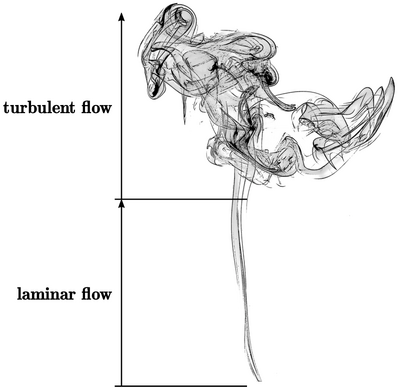Chapter 6 Introduction to Turbulence
“But never have I been a blue calm sea, I have always been a storm.”
Fleetwood Mac, Storms (1979).
The previous chapters provide some general principles for CFD, from the governing equations and common models, to numerical methods, boundary conditions, algorithms and solvers.
Since the book is about general principles, it does not generally cover complex physical modelling. The exception is turbulence which need to be addressed since it is so common in fluid flow and therefore a critical part of most CFD simulations.
Turbulence is
illustrated by a plume of smoke below. The smoke rises vertically
from the base, initially tracing a relatively straight, narrow
path, characteristic of laminar
flow. At some point, there is an
abrupt transition to turbulent
flow in which fluid particles follow
curved paths which cross one another in a disorderly, irregular
manner, causing  and
and  to fluctuate randomly in time.
to fluctuate randomly in time.
Turbulent flow evidently involves significant mixing of the fluid which is an important consideration in many CFD problems. For example, it directly affects the rate of pollutant dispersion and the rate of reaction of a chemical process. It causes heat to diffuse more rapidly. Similarly, mixing affects momentum diffusion and, consequently, the aerodynamic forces within a fluid and surrounding vehicles, wind turbines, buildings, etc.

Turbulence is a vast subject with an abundance of textbooks for various levels of expertise. As an introduction to turbulence, this chapter aims to provide:
- a short description of the nature of turbulence;
- an understanding of its importance in analysis and particular challenges it presents in CFD;
- the basic concepts of turbulence modelling to lay the groundwork for the models presented in Chapter 7.
6.2 A picture of turbulence
6.3 Vorticity transport
6.4 Boundary layers
6.5 Boundary layer separation
6.6 Scales of turbulence
6.7 Energy cascade
6.8 The cost of simulating turbulence
6.9 Reynolds-averaged simulation
6.10 The nature of viscosity
6.11 Turbulent mixing
6.12 Mixing length
6.13 Turbulent kinetic energy
6.14 Turbulent dissipation rate
6.15 Summary of turbulence

